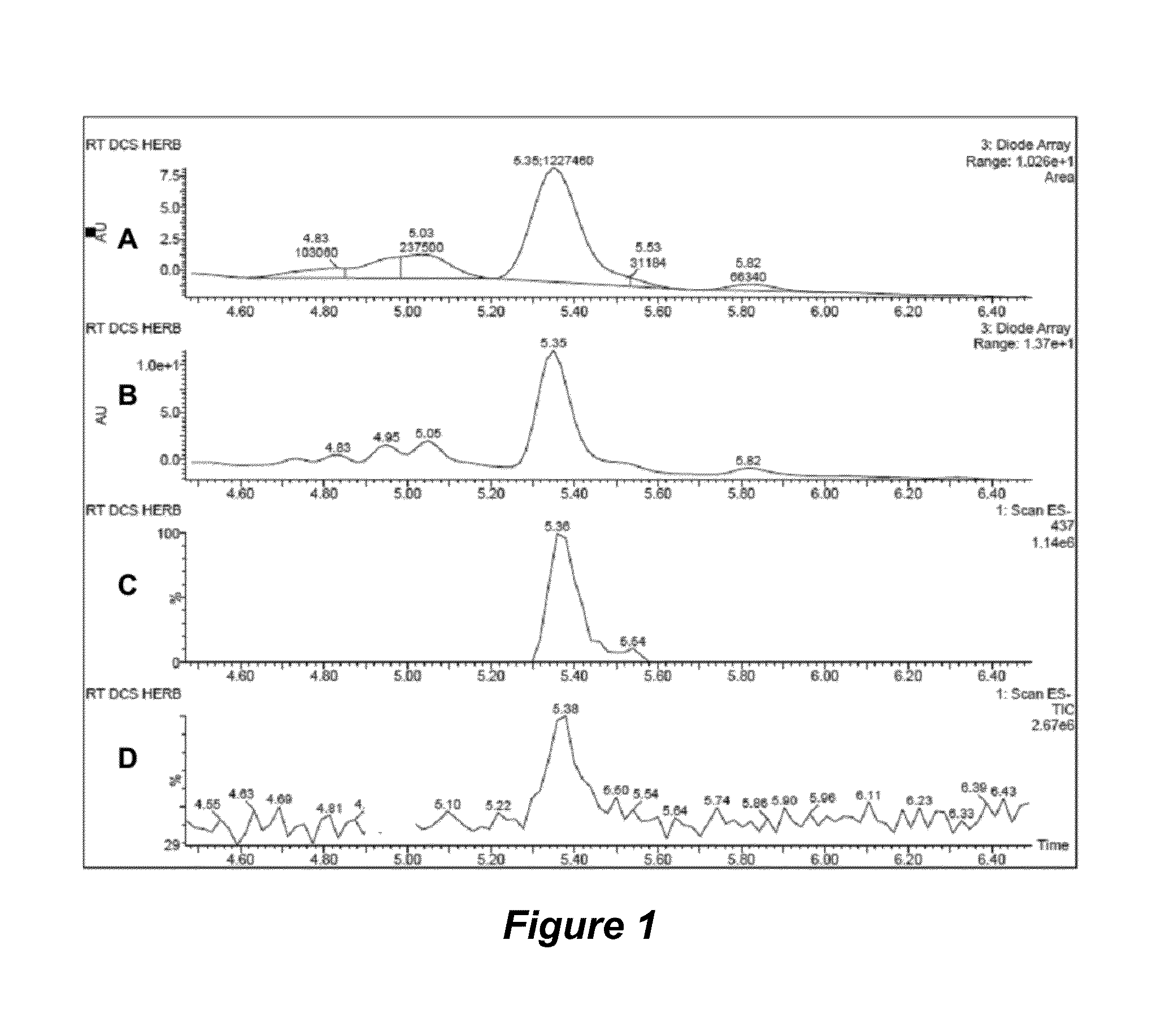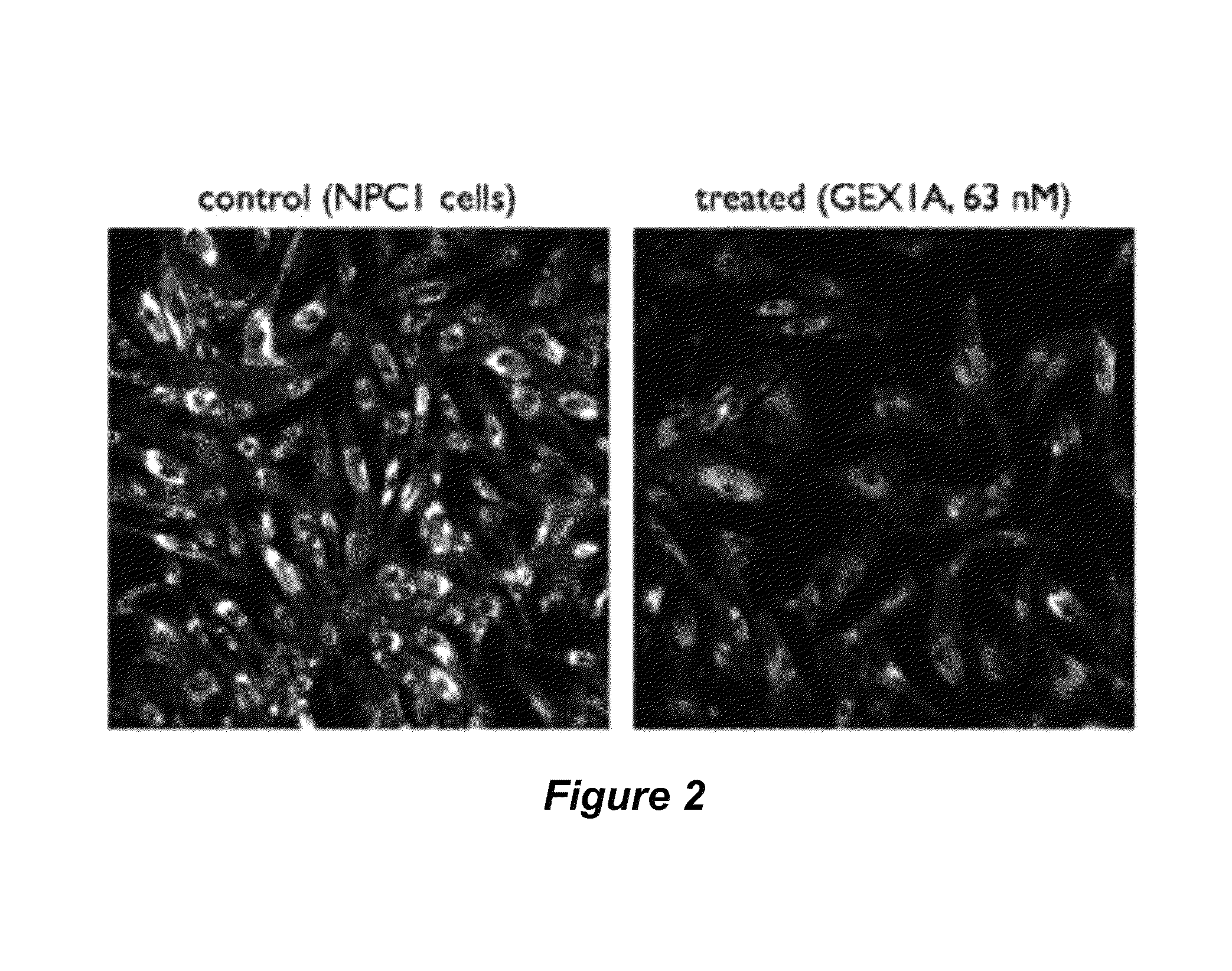Regulation of cholesterol homeostasis
a cholesterol homeostasis and homeostasis technology, applied in the direction of biocide, aerosol delivery, inorganic non-active ingredients, etc., can solve the problems of unreliable biochemical testing to detect carrier status, rapid neonatal death, chronic neurodegenerative symptoms in children and adults
- Summary
- Abstract
- Description
- Claims
- Application Information
AI Technical Summary
Benefits of technology
Problems solved by technology
Method used
Image
Examples
example 1
Cultivation of GEX1A from Streptomyces chromofuscus
[0095]Streptomyces chromofuscus, ATCC 49982, was acquired from the ATCC and maintained on Bennett's Agar (0.1% yeast extract, 0.1% beef extract, 0.2% NZ amine A, 1% glucose, and 2% agar, pH 7.2), ISP2 Agar (1.0% malt extract, 0.4% yeast extract, 0.4% glucose, 2.0% agar), or Seed Medium (0.3% yeast extract, 0.5% tryptone). Production of GEX1A from S. chromofuscus was conducted in a developed GEX1A production medium (2.0% soy flour, 2.0% glucose, 0.05% yeast extract, 0.1% MgSO4.7H2O, 0.2% KH2PO4, 0.2% KNO3, 0.05% NaCl, 0.015% CaCO3, 0.0001% ZnSO4.7H2O, 0.018% Fe-EDTA, 2.0% Agar).
[0096]S. chromofuscus was inoculated onto ISP2 plates and incubated at 25° C. for 5 to 6 days. The fresh spores were then inoculated into 5 mL of Seed Medium and cultured at 30° C. with shaking for 4 days. The 5 mL seed culture was then spread onto GEX1A production medium plates and cultured at 25° C. for 7 to 10 days. After incubation, the plates were homoge...
example 2
Synthesis of a Pyran Fragment (Formula III)
[0098]The synthesis of Formula IV can be accomplished as set forth in Scheme 1 below. A starting homoallylic alcohol 25 can be protected as its corresponding 2-naphthylmethoxymethyl ether. Exposure to classic ether transfer conditions would provide a terminal iodide, which can be used in an intramolecular radical cyclization reaction to produce a C1-C10 pyran fragment under classic tributyltin hydride / AIBN conditions. The naphthylmethyl ether can then be deprotected by mild aqueous oxidation conditions with DDQ. Barton deoxygenation and Stille cross coupling would complete the synthesis of the C1-C10 pyran fragment, which is a substructure of GEX1A analogues.
[0099]
[0100]Compound 25 can be contacted with NapOCH2CI and iPr2Net, and then ICl, PhCH3 at −78° C. to yield a terminal iodide with high diastereoselectivity. The resulting solution can then be then treated with Bu3P, HCCCO2CH3 to achieve homologation of the secondary alcohol to the vin...
example 3
Synthesis of an Epoxide Fragment (Formula II) and Coupling Reactions
[0101]Isobutyl lactate was protected at the secondary alcohol as benzyoxymethyl ether, as shown in Scheme 2. Exposure to a series of reduction-oxidation provides an aldehyde substrate (42) for a Keck diastereoselective crotylation. The compound then underwent methyl ether formation to provide olefin compound 40. Specifically, isobutyl lactate was treated with BOMCl, TBAI, and iPr2NEt in CH2Cl2; then LAH in Et2O; followed by Swern oxidation. The resulting aldehyde 42 was treated as shown in Scheme 2 in the presence of MgBr2.Et2O, KH, and CH3I to yield alkene 40.
[0102]
[0103]The 1,1-disubstituted alkene compound (41) can be separately prepared by generating sodium enolate from ephedrine-based propionate with methylallyl iodide in the presence of a strong base such as sodium hexamethyldisilazide. Reductive cleavage of the auxiliary of compound 44 can be followed by protection of the resulting primary alcohol as a tert-b...
PUM
| Property | Measurement | Unit |
|---|---|---|
| temperatures | aaaaa | aaaaa |
| temperature | aaaaa | aaaaa |
| temperature | aaaaa | aaaaa |
Abstract
Description
Claims
Application Information
 Login to View More
Login to View More - R&D
- Intellectual Property
- Life Sciences
- Materials
- Tech Scout
- Unparalleled Data Quality
- Higher Quality Content
- 60% Fewer Hallucinations
Browse by: Latest US Patents, China's latest patents, Technical Efficacy Thesaurus, Application Domain, Technology Topic, Popular Technical Reports.
© 2025 PatSnap. All rights reserved.Legal|Privacy policy|Modern Slavery Act Transparency Statement|Sitemap|About US| Contact US: help@patsnap.com



